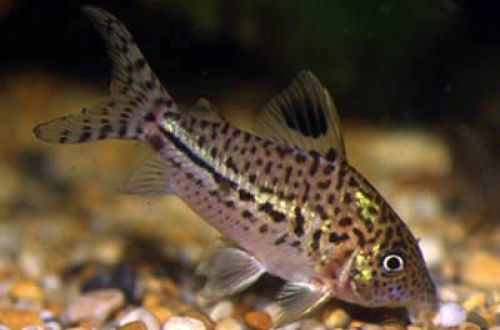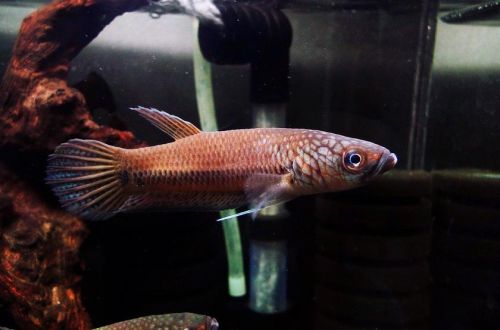
Kardinali
Cardinal, scientific name Tanichthys albonubes, belongs to the Cyprinidae family. The most popular aquarium fish, easy to keep and breed. As of 2010, there are four well-established breeding color forms, but only two of them are most widely used – close to natural color and with a predominance of red.
Yaliyomo
Habitat
The homeland of the species is the territory of modern China. Currently, fish are practically not found in the wild and are on the verge of extinction, listed in the Red Book. Several relict populations have been found in the coastal province of Guangdong (southern China) and in the province of Quang Ninh, northeast Vietnam. They live in slow-flowing rivers and streams, prefer to stay at shallow depths up to 60 cm near dense coastal aquatic vegetation.
Maelezo mafupi:
- Kiasi cha aquarium - kutoka lita 60.
- Joto - 14-22 ° C
- Thamani pH - 6.0-8.5
- Water hardness – soft to hard (5-21dGH)
- Aina ya substrate - yoyote
- Taa - imepunguzwa
- Maji ya chumvi - hapana
- Harakati ya maji - sasa dhaifu au bado maji
- Ukubwa wa samaki ni hadi 4 cm.
- Chakula - chakula chochote
- Temperament - samaki utulivu wa amani
- Kuweka katika kundi la watu 10
Maelezo
Adults reach a length of 4 cm. Females are somewhat larger than males, but less colorful. There are several color forms. One is closer to natural coloration, the dominant color is gray with a wide bright pink stripe stretching from head to tail. The wide fins have a pale yellow edging. Another form has a similar color, but with a pronounced red pigment, which is painted on the back of the body, tail and edges of the fins.
chakula
They accept all types of dry, frozen and live food. A combination of different species is the most preferred option, in this case the fish show their best color. Feed 2-3 times a day in the amount eaten in 5 minutes, remove leftovers in a timely manner to prevent water pollution.
Matengenezo na huduma, mpangilio wa aquarium
The recommended volume of the tank for one flock of fish starts from 60 liters. The design is arbitrary, however, a combination of a dark substrate and a certain amount of floating plants is considered the best option. Artificial or natural snags, roots and / or branches of trees are used as decor.
The standard set of equipment consists of filtration and lighting systems, an aerator. The cardinal prefers relatively low temperatures, so there is no need for a heater if the aquarium is set up in a living area.
Water conditions are characterized by a weak internal flow, temperature, pH and dGH parameters are in a wide acceptable range of values, so the preparation of water is not associated with great difficulties, in most cases it is enough to defend it during the day.
Matengenezo ya Aquarium yanajumuisha uingizwaji wa kila wiki wa sehemu ya maji (20-25% ya kiasi) na maji safi, kusafisha mara kwa mara ya substrate kutoka kwa taka ya kikaboni na kuondolewa kwa plaque kutoka kioo.
Tabia na Utangamano
Calm peace-loving fish, goes well with other species of similar size and temperament, able to live in similar temperature conditions. The content is flocking from 10 individuals of both sexes; within the group, males are forced to compete with each other for the attention of females, which contributes to an increase in the brightness of their color.
Ufugaji/ufugaji
Cardinal refers to spawning species, females scatter eggs in the water column, and males at this moment fertilize it. Parental instincts are poorly developed, immediately after spawning, the fish can eat their own caviar and fry that have appeared.
Ufugaji unapendekezwa kufanywa katika tank tofauti - aquarium ya kuzaa, ili kulinda watoto kutoka kwa samaki wazima. Ubunifu ni rahisi, umakini mkubwa hulipwa chini, inapaswa kuwa na chembe za saizi kubwa ya kutosha ambayo haifai kwa kila mmoja, na kutengeneza voids, kwa mfano, kokoto au shanga za glasi za mapambo. Wakati mayai yanapozama chini, wengi wao huanguka kwenye tupu hizi na hivyo kuwa haiwezekani kwa samaki. Athari sawa pia hupatikana wakati wa kutumia mesh nzuri, ambayo imewekwa chini.
Njia nyingine ya kuhakikisha uhifadhi wa mayai ni kutumia mimea yenye majani madogo au mosi zinazoota kidogo kama vile Riccia inayoelea na moss ya Javanese, ambayo hupandwa kwenye sehemu kubwa ya uso wa substrate (katika kesi hii, udongo unaweza kuwa wowote) . Vichaka mnene vya mimea vinaweza kutoa makazi ya kuaminika kwa mayai sio mbaya zaidi kuliko udongo maalum.
Ukubwa wa aquarium ya kuzaa ni kawaida lita 20-30, nusu imejaa. Vifaa vinavyotumiwa ni kipeperushi, hita na chujio rahisi cha sifongo cha nguvu ndogo ili kuzuia kufyonza kwa bahati mbaya kwa mayai na kaanga. Kuzaa hutokea katika mwanga hafifu, hivyo mwanzoni hakuna haja ya chanzo cha mwanga.
The impetus for the beginning of the mating season is the establishment of a water temperature in the region of the upper permissible mark of 20–21 ° C at a neutral or slightly acidic pH value, as well as the inclusion of protein foods in the daily diet – bloodworms, daphnia, brine shrimp in live or frozen form.
After some time, the females become noticeably rounder, and the males will begin to actively show signs of attention to their chosen ones. At this point, you should prepare a separate tank and fill it with water from the general aquarium, then transplant several females and the most colorful males there. The easiest way to determine the end of spawning is by females, they will become slender.
Samaki wanarudishwa. Fry itaonekana katika masaa 48 - 60, na siku nyingine wataanza kuogelea kwa uhuru. Lisha na chakula maalum cha hadubini kwa kulisha samaki wachanga wa aquarium.
Magonjwa ya samaki
Due to long-term hybridization and inbreeding, undesirable consequences appeared in the form of weak immunity and a high proportion of congenital malformations among juveniles. A balanced diet and suitable living conditions reduce the risk of disease, but do not eliminate them. Read more about symptoms and treatments in the Aquarium Fish Diseases section.





